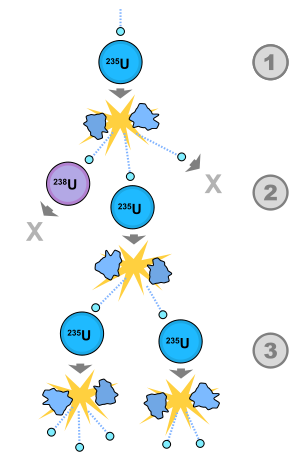


 علم الكيمياء
علم الكيمياء 
 الكيمياء التحليلية
الكيمياء التحليلية 
 الكيمياء الحياتية
الكيمياء الحياتية 
 الكيمياء العضوية
الكيمياء العضوية 
 الكيمياء الفيزيائية
الكيمياء الفيزيائية
 الكيمياء اللاعضوية
الكيمياء اللاعضوية 
 مواضيع اخرى في الكيمياء
مواضيع اخرى في الكيمياء
 الكيمياء الصناعية
الكيمياء الصناعية |
Read More
Date: 2-9-2020
Date: 1-9-2020
Date: 1-1-2017
|
In both fission and fusion, large amounts of energy are given off in the form of heat, light, and gamma radiation. Nuclear fission was discovered in the late 1930's when U-235 nuclides were bombarded with neutrons and were observed to split into two smaller-mass nuclei.
The products shown are only one of many sets of products from the disintegration of a U-235 nucleus. Over 35 different elements have been observed in the fission products of U-235.

Figure 1 : A possible nuclear fission chain reaction. 1. A uranium-235 atom absorbs a neutron, and fissions into two new atoms (fission fragments), releasing three new neutrons and a large amount of binding energy. 2. One of those neutrons is absorbed by an atom of uranium-238, and does not continue the reaction. Another neutron leaves the system without being absorbed. However, one neutron does collide with an atom of uranium-235, which then fissions and releases two neutrons and more binding energy. 3. Both of those neutrons collide with uranium-235 atoms, each of which fissions and releases a few neutrons, which can then continue the reaction. (Public Domain).
When a neutron strikes a U-235 nucleus and the nucleus captures a neutron, it undergoes fission producing two lighter nuclei and three free neutrons. The production of the free neutrons makes it possible to have a self-sustaining fission process - a nuclear chain reaction. It at least one of the neutrons goes on to cause another U-235 disintegration, the fission will be self-sustaining.



|
|
|
|
التوتر والسرطان.. علماء يحذرون من "صلة خطيرة"
|
|
|
|
|
|
|
مرآة السيارة: مدى دقة عكسها للصورة الصحيحة
|
|
|
|
|
|
|
نحو شراكة وطنية متكاملة.. الأمين العام للعتبة الحسينية يبحث مع وكيل وزارة الخارجية آفاق التعاون المؤسسي
|
|
|